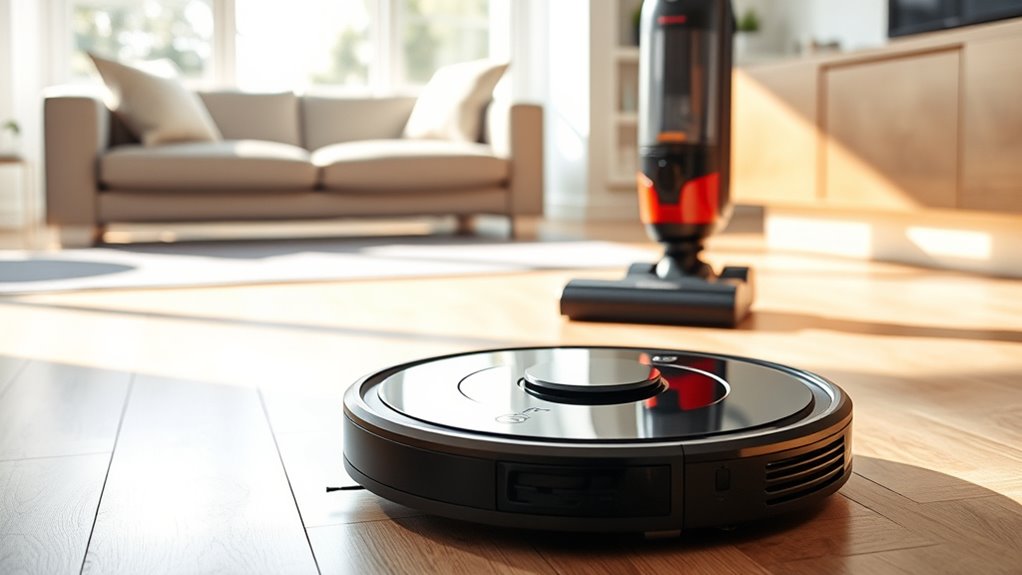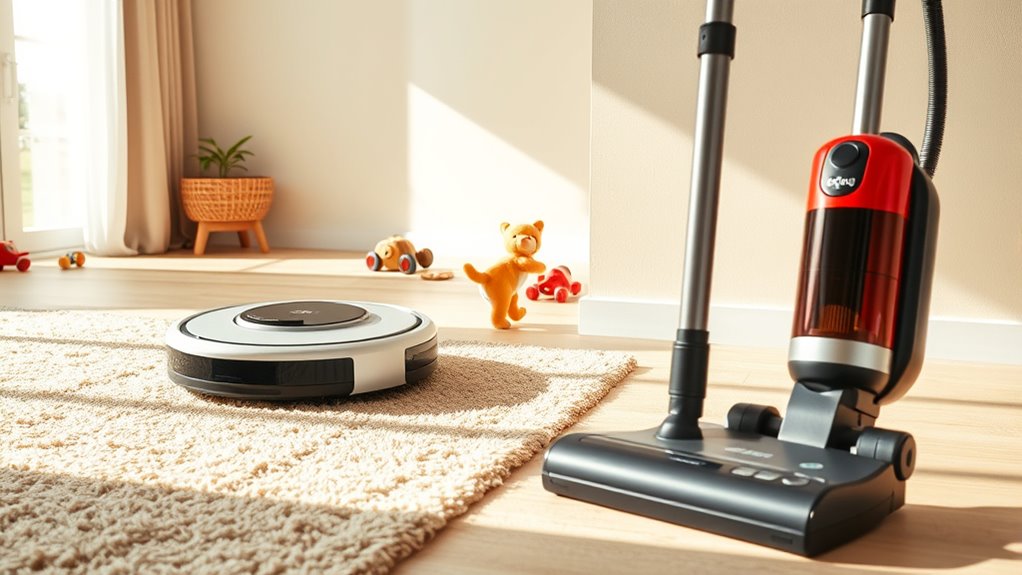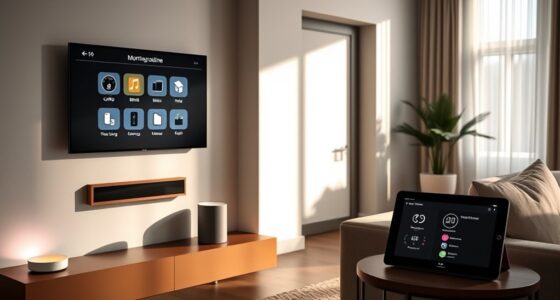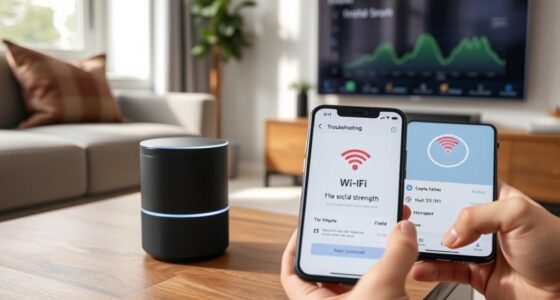If you prioritize convenience and regular cleaning, a robot vacuum can be a smart choice, especially for smaller homes or busy households. They run automatically and reduce manual effort, but may lack the deep cleaning power of traditional vacuums. Consider your home size, noise preferences, and cleaning needs to decide if a smart cleaner is worth it. Keep exploring to discover which type best fits your lifestyle and how to make the most of your cleaning options.
Key Takeaways
- Robot vacuums offer convenience with scheduled, automatic cleaning, reducing manual effort but may lack deep cleaning power.
- Traditional vacuums excel at heavy-duty tasks and handling stubborn dirt, especially on tough or deep-seated messes.
- Battery life varies; longer-lasting models suit large homes, while shorter batteries may require frequent recharging.
- Noise levels differ; robot vacuums tend to be quieter, making them ideal for households with pets or children.
- Overall value depends on household size, cleaning needs, and preference for automation versus intensive cleaning performance.

When it comes to keeping your home clean, robot vacuums have become a popular alternative to traditional cleaners. These smart devices offer convenience and automation, but before you decide to make the switch, it’s important to consider some key factors like battery life and noise levels. Your daily routine and home environment can greatly influence whether a robot vacuum is a practical choice for you.
Battery life is one of the most critical aspects to evaluate. You want a robot vacuum that can cover enough ground in a single charge to handle your cleaning needs. Some models boast impressive battery lives, allowing them to clean large areas without needing to recharge frequently. Others may struggle with shorter battery spans, requiring you to manually recharge or restart the device mid-clean. If you have a big home or multiple rooms that need cleaning, investing in a model with a longer-lasting battery can save you time and effort. It also means less downtime and fewer interruptions during your cleaning schedule.
Long-lasting batteries ensure your robot vacuum cleans more without frequent recharges.
Noise levels are another significant consideration. Traditional vacuums can be loud, which might be disruptive, especially if you have a busy household or pets that get startled easily. Robot vacuums, on the other hand, tend to operate more quietly, but noise levels can still vary between models. Some are whisper-quiet, barely making a sound, while others can produce a noticeable hum. If you work from home, have small children, or pets that are sensitive to noise, choosing a robot vacuum with low noise levels can make a big difference in your daily comfort.
In addition to these factors, some robot vacuums incorporate advanced navigation systems that help them efficiently map and clean your space, reducing missed spots and ensuring thorough coverage. While traditional vacuums often provide more power and thorough cleaning on stubborn dirt, robot vacuums excel in maintaining your floors regularly with minimal effort. They can be scheduled to run automatically, saving you time and ensuring your home stays tidy without constant supervision. However, they may struggle with certain surfaces or tight spaces, which could mean occasionally needing to switch to a traditional vacuum for a deep clean.
Ultimately, whether a robot vacuum is worth it depends on your lifestyle and household needs. If you prioritize convenience, have a smaller home, or want a device that can run quietly and efficiently throughout the day, a smart cleaner could be a worthwhile investment. But if you require heavy-duty cleaning or have specific performance expectations, traditional vacuums still hold significant advantages. Carefully weigh these factors to decide which option aligns best with your cleaning routine.
Frequently Asked Questions
How Long Do Robot Vacuums Typically Last Before Needing Replacement?
Your robot vacuum’s battery lifespan typically ranges from 1 to 3 years, depending on usage and maintenance. Replacement frequency varies, but most batteries last around 300-500 charge cycles before needing replacement. To maximize lifespan, keep the battery charged correctly and clean the brushes regularly. When performance declines or the battery no longer holds a charge well, it’s time to think about replacing the battery to keep your vacuum working efficiently.
Can Robot Vacuums Handle All Types of Flooring Effectively?
Think of your robot vacuum as a versatile dancer, gracefully moving across your floors. It handles a range of surfaces, providing excellent flooring versatility. It cleans hardwood, tile, and low-pile carpets with ease, though its carpet performance might slightly lag on thick, high-pile rugs. Overall, it’s a reliable performer that adapts well, but for deep cleaning on certain carpets, manual touch-ups might still be needed.
Are There Any Safety Concerns With Robotic Vacuum Cleaners?
You might wonder about safety when using robotic vacuum cleaners. Child safety is a concern because curious kids could tamper with moving parts or small detachable components. Battery hazards are also possible if the vacuum’s lithium-ion battery gets damaged or overheats. To minimize risks, keep children away during operation, regularly inspect the device, and follow manufacturer instructions. Proper use guarantees your robotic vacuum remains a safe cleaning companion.
Do Robot Vacuums Work Well in Homes With Pets or Children?
You’ll find that robot vacuums work well in homes with pets or children, efficiently cleaning up pet hair and crumbs. They help maintain a tidy space without disturbing kids or pets, thanks to quiet operation and safety features. However, verify your robot vacuum has child safety locks and is suitable for pet hair. Regularly empty the bin and check for pet or child safety to keep your home clean and secure.
How Much Maintenance and Cleaning Do Robot Vacuums Require?
Think of your robot vacuum as a diligent garden gnome—small but needing regular attention. You’ll want to keep an eye on its battery life and charge it before it’s drained. Cleaning involves emptying the dustbin and occasionally wiping sensors. Typically, a quick weekly check-up ensures peak performance. With proper upkeep, your smart cleaner will happily chug along, making cleaning less of a chore and more of a breeze.
Conclusion
Choosing between a robot vacuum and a traditional cleaner is like deciding whether to ride a swift, autonomous streamliner or steer your own trusty vintage bike. The robot’s convenience is a breeze that glides effortlessly, freeing your time like a gentle river flowing around obstacles. However, if you crave control and thoroughness, a traditional cleaner is your sturdy, reliable vessel. Ultimately, smart technology can be your effortless companion, but your hands-on cleaner remains the steadfast hero of clean.









